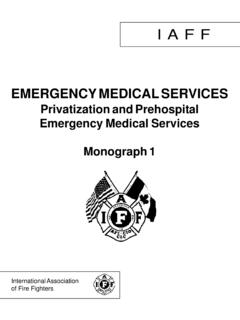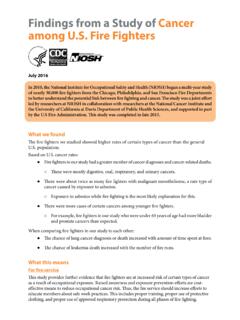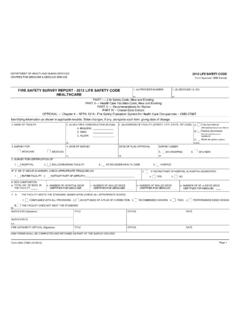Transcription of NFPA Standard 1710 - International Association of Fire ...
1 History and PurposenThe 1710 Standard for was originally released in 2001. Following, therehave been three revisions (2004, 2010, 2016) with the most recentreleased in September 2016. nThe Standard is applicable to substantially all CAREER fire departments andprovides the MINIMUM requirements for resource deployment for firesuppression, EMS and Special Operations while also addressing fire fighteroccupational health and 1710 Standard addresses structure fire in three hazard levels. Theseincluded low hazard (residential single-family dwellings), medium hazard(three story garden apartments or strip malls), and high hazard structures(high-rise buildings). nThe Standard addresses fire suppression, EMS, Aircraft Rescue andFirefighting, Marine Rescue and Firefighting, Wildland Firefighting, andMutual and Auto Suppression and Special Operations Provisionsn Company is defined as: Group of members under direct supervision Trained and equipped to perform assigned tasks Organized and identified as engine, ladder, rescue, squad ormulti-functional companies Group of members who arrive at scene and operate with one apparatusnEXCEPTION to company arriving on one apparatus.
2 Multiple apparatuses are assigned, dispatched and arrivetogether Continuously operatetogether Managed by a single officernAn Initial Alarm is personnel, equipment and resources originally dispatchedupon notification of a structure Objectives Alarm Answering Time 15 sec 95% 40 sec 99% Alarm Processing Time 64 sec 90% 106 sec 95% Turnout Time = 60 sec EMS 80 sec fire First Engine Arrive on Scene Time 240 sec (4 min) Initial Full Alarm (Low andMedium Hazard) Time 480 sec (8 min) Initial Full Alarm High Hazard/ High-Rise Time 610 sec (10 min 10 sec)nFire departments shall set forth criteria for various types of incidents towhich they are required/expected to respond. These types of incidentsshould include but not be limited to the following: Natural disaster Acts of terrorism WMD Large-scale mass casualtyOrganization and Deployment of fire Suppression Operations, EMS and Special Operations in Career fire DepartmentsNFPA Standard 1710 nGiven expected firefighting conditions, the number of on-duty membersshall be determined through task analysis considering the following criteria.
3 Life hazard protected population Safe and effective performance Potential property loss Hazard levels of properties Fireground tactics employednCompany Staffing (Crew Size) Engine = minimum 4 on duty High volume/geographic restrictions = 5 minimum on duty Tactical hazards dense urban area = 6 minimum on duty Truck = minimum 4 on duty High volume/geographic restrictions = 5 minimum on duty Tactical hazards dense urban area = 6 minimum on dutynInitial Alarm Deployment (*number of fire fighters including officers) Low hazard = 15 fire fighters Medium hazard = 28 fire fighters High hazard = 43 fire fightersEMS ProvisionsnThe fire department shall clearly document its role, responsibilities, functionsand objectives for the delivery of EMS. EMS operations shall be organizedto ensure the fire department s capability and includes members, equipmentand resources to deploy the initial arriving company and additional Treatment Levels include: First Responder Basic Life Support (BLS) Advanced Life Support (ALS)nMINIMUM EMS Provision = First responder/AEDnAuthority-Having Jurisdiction (AHJ) should determine if fire Departmentprovides BLS, ALS services, and/or transport.
4 Patient treatment associatedwith each level of EMS should be determined by the AHJ based onrequirements and licensing within each EMS units shall be staffed with the minimum members necessaryfor emergency medical care relative to the levelof EMS provided by the deployed to ALS emergency responses shall include: A minimum of two members trained at the emergency medicaltechnician paramediclevel AND two members trained at the BLS level arriving on scene within theestablished travel fire departments with ALS services shall have a named medicaldirectorwith the responsibility to oversee and ensure quality medical carein accordance with state or provincial laws or regulations and must have amechanism for immediate communicationwith EMS supervision andmedical oversight.















